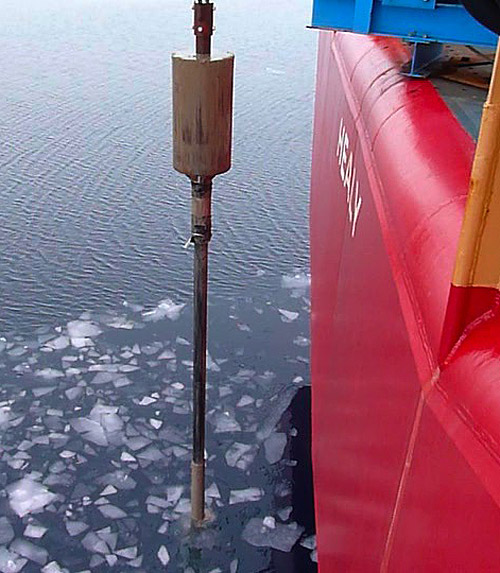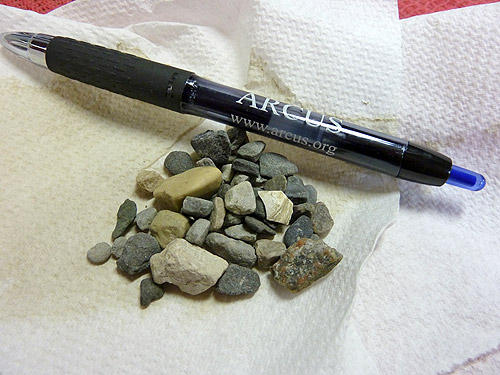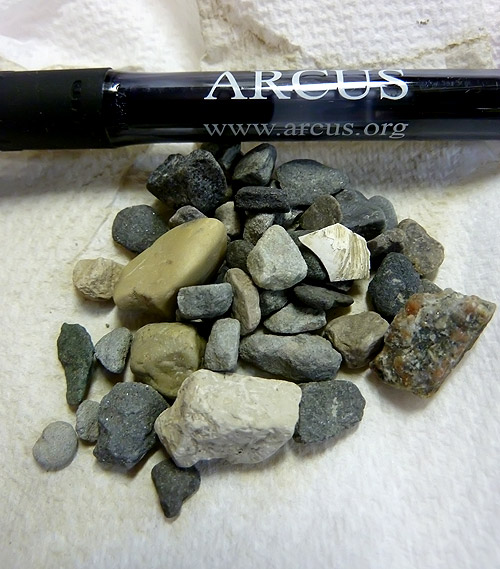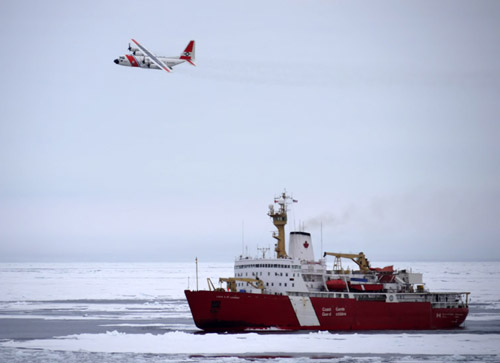Speed 4 knots (kts) Course 295° Location Eastern Canada Basin, 76.79° N, 133.68° W Depth 3420 meters
SPECIAL FEATURE DISCUSSION:
(see previous journal for the questions.)
The Beaufort GyreA spiral oceanic surface current driven by the wind. rotates clockwise in the Arctic Ocean, circulating ice along with it. As the ice pack heads towards Greenland, some diverts along the east coast and out of the Arctic via the Labrador Current, moving southward into the North Atlantic Ocean. But ice passing along the north side of Greenland and towards the Queen Elizabeth Islands gets slowed down and held longer, constricted by the land. This gives it a better chance of remaining for multiple years, freezing thicker every winter. Ice that is carried by the Beaufort GyreA spiral oceanic surface current driven by the wind. away from the Queen Elizabeth Islands into the Beaufort SeaThe Beaufort Sea lies to the north of Alaska and the Yukon and Northwest Territories. and other more southerly parts of the Arctic Ocean finds areas where it is more likely to break up and melt. A disturbing trend has been the rapid decrease in the amount of multi-year ice in the Arctic Ocean over the last decade.
TODAY'S JOURNAL:
We had a successful piston core recovery yesterday, earning us nearly 5 meters of sea floor sediment. The piston coring rig came back muddy all the way to the top of the 2400-lb. weight at the top, and I noticed some of the mud clinging to the outside had little bits of rock and pebbles in it. Once the core liner gets trimmed into workable lengths, capped, and labeled, it is taken into the lab for more processing before storage in the walk-in refrigerator. Then Pete and Jenny, our Marine Techs, hose everything down to clean up. As they were rinsing mud off the coring rig I noticed some of the pebbles that had been washed onto the deck and started a collection. Pete & Jenny caught my interest and helped me gather samples of the rocky bits. When they were about done with the final deck hose-down a little pile of pebbles was left that they graciously scooped up for me instead of hosing them overboard.

Besides being a neat memento from the Arctic Ocean sea floor, each pebble would have a compelling tale to tell could they speak. They certainly didn't form at the coring site, in water over 2000 meters deep where the top 5 meters of sediment was all mud (excepting these little pebbles.) With the exception of one or two nicely rounded specimens the pebbles are pretty rough, most only moderately smoothed and others downright jagged. This would suggest limited (if any) stream or river travel or time on a beach, environments which quickly round and smooth rocks by abrasion. Each probably travelled a fair distance to get to their resting place on the sea floor, some perhaps coming from very far away. Another clue to the processes at work is the variety of rock types represented in the pebbles. Closer analysis with a microscope would help, but looking backwards through binoculars is a pretty effective way to get a magnified look. Many are dark gray and fine-grained (with crystals not visible to the bare eye or even under moderate magnification), probably a type of volcanic rock called basalt. There is a jagged lighter pebble with pink and gray crystals visible to the naked eye, either granite or a related rock. Another is dark and sparkly- with blackish crystals just big enough to see with the bare eye. Perhaps it is a fine gabbro or other mafic intrusive or metamorphic rock. A few are creamy yellowish-gray and relatively soft- my knife will scratch them. I suspect they are limestone or dolomite and a simple acid test back home could confirm this suspicion (limestone will fizz in dilute hydrochloric acid, as will powdered dolomite.) There's even a clam shell fragment in my little collection. With the variety of rock types represented it is pretty clear that even though they all came to rest in the same tiny patch of sea floor, they originated in different widely spread source areas. There must be a mechanism to bring these pebbles from many disparate areas out into the Canada Basin.


We had another type of visitor that travelled a long way to get to our location yesterday as a US Coast Guard C-130 cargo plane from Kodiak, Alaska gave us a flyby. It carried the vice-commandant of the Coast Guard along with other dignitaries on a tour of the region. They were seeing first-hand the scope of the ice-scape here and the working environment of the Healy and other arctic operations. It was pretty neat to see how equipment like the C-130 can get to some amazingly harsh & remote areas carrying a lot of gear! This is the type of plane that is used to land, via skis instead of wheels, on the ice caps of Greenland and Antarctica to support researchers there.


SPECIAL FEATURE:
Propose a way that the pebbles in my collection found themselves at the bottom of the Canada Basin, over 2000 meters deep and far from land, in an otherwise muddy environment. Think like a detective about the clues and keep in mind the setting up here!
That's all for now! Best- Bill


Comments